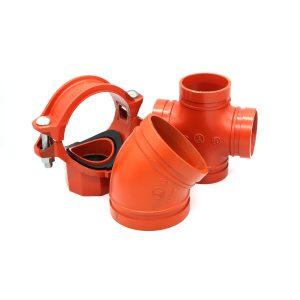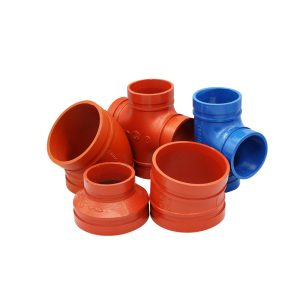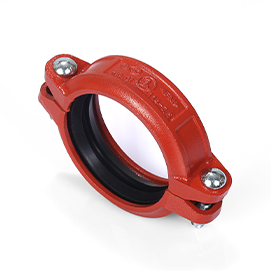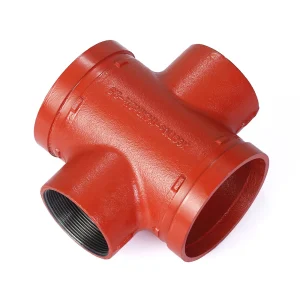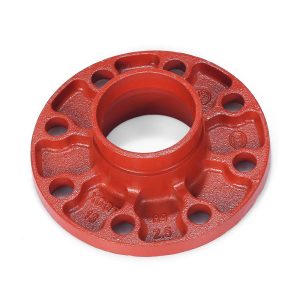
Picture this: You’re knee-deep in a retrofit job on a high-rise fire protection system. The old piping’s a mess, and now you’ve got to hook up a new pump with flanges that just won’t play nice with the rest of the setup. Sweat’s building, deadlines are looming, and that nagging worry hits—will this connection hold under pressure, or are you looking at leaks down the line? It’s a headache every engineer dreads. But here’s the good news: grooved flanges can turn that nightmare into a straightforward fix. In this post, we’ll break down the connection challenge, zero in on using grooved flanges to interface with pump flanges, and show you how to make it work without the drama.
I’ve been around piping projects long enough to know these moments. Sometimes, it’s not the big stuff that trips you up—it’s the interfaces, those stubborn spots where systems meet. Let’s dive in and sort this out.
What Makes Piping Connections Such a Headache?
Piping systems in buildings, factories, or even water treatment plants aren’t just straight runs of pipe. They’re a web of transitions—valves to pumps, ducts to mains, you name it. And when it comes to pump flanges, things get tricky fast. These flanges are often beefy, designed for high torque and vibration, but they’re not always a perfect match for grooved piping downstream.
The Usual Suspects: Leaks, Misalignments, and Downtime
Think about a typical fire protection setup. You’ve got carbon steel pipes with grooves for quick assembly, but the pump’s got ANSI-flanged ends staring back at you. Bolt them up wrong, and boom—misalignment stresses the joints, leading to gaskets failing under 200 PSI. Data from industry reports shows that up to 30% of piping failures stem from poor flange connections, costing projects thousands in rework.
It’s not just leaks, either. Vibration from the pump can chew through seals over time. I remember a job site in the Midwest where a mismatched interface turned a two-day install into a week-long ordeal. Crews were chasing phantom drips, and the whole floor got shut down. Frustrating? Absolutely. Avoidable? You bet, with the right approach.
Why Pump Flanges Throw a Curveball
Pump flanges aren’t your average bolt circle. They’re built tough—often raised-face or flat-face designs per ASME B16.5—to handle axial loads and thermal expansion. But interface them with grooved systems, and you’ve got thermal mismatches, differing expansion rates, and the hassle of field welding or threading. In cold climates, that can mean frost heaves cracking the setup before winter even bites.
Short version: Without a smart bridge, you’re fighting physics. Enter grooved flanges. These aren’t a band-aid; they’re the connector that speaks both languages—flanged and grooved—without compromising flow or pressure ratings.
Grooved Flanges: Your Bridge to Seamless Interfaces
Grooved flanges aren’t new, but they’re a game-changer for solving the connection challenge. At their core, they’re adapters that let you transition from a flanged pump end to a grooved pipe run. No torches, no heavy bolting—just roll it on, tighten the couplings, and you’re done.
Breaking Down the Basics of Grooved Flanges
A grooved flange typically features a ductile iron body with a machined groove on one end and bolt holes on the other to match the pump’s flange pattern. Sizes run from 2 inches up to 12 inches or more, handling pressures from 225 PSI to 363 PSI depending on the model. Materials? Think ASTM A536 Grade 65-45-12 for that ductile toughness—resists cracking under impact, holds up in corrosive spots.
They’re rated for temperatures from -20°F to +180°F, so whether you’re in a sweltering boiler room or a chilly pump house, they won’t flinch. Design standards like AWWA C606 and ISO 6182 keep things legit, ensuring the groove depth and width play nice with standard couplings.
One quirk I like: These flanges often come epoxy-coated for extra rust protection. In a salty coastal install, that coating’s saved more than a few crews from callback hell.
Key Wins When Interfacing with Pump Flanges
Using grooved flanges here isn’t just convenient—it’s smart engineering. First off, installation speed. Traditional flanged joints? You’re looking at 20-30 minutes per connection with torque wrenches and alignment shims. Grooved? Under 10 minutes, tools in hand. That adds up on a 50-connection job—hours saved, labor costs down.
Then there’s flexibility. Pumps vibrate; pipes shift. Grooved systems absorb that without transmitting stress to the flange. Studies from piping labs show up to 50% less fatigue in these setups compared to rigid bolted joints.
And reliability? Gaskets in grooved flanges are EPDM or nitrile, sealing tight against water, steam, or mild chemicals. In a 2019 case from a Midwest water plant, swapping to grooved interfaces cut leak incidents by 40% over five years. Numbers like that don’t lie.
But it’s not all smooth sailing. Pick the wrong size, and you’ll gap out the alignment. That’s why matching the pump’s bolt pattern—say, 150# or 300# class—is non-negotiable.
Step-by-Step: Making Grooved Flanges Work for Your Pump Setup
Alright, theory’s fine, but how do you actually pull this off? Let’s walk through it like you’re on-site, coffee in hand, blueprint spread out.
Prep Work: Size It Up Right
Start with the pump specs. Note the flange size (DN50 to DN300 is common), pressure class, and facing type. Cross-check against your grooved flange catalog. For a 225 PSI adapter, you’re golden for most centrifugal pumps under 4 inches.
- Measure twice: Flange OD, bolt circle diameter, and hole count. A half-inch off, and you’re drilling new holes—painful.
- Check the groove: Ensure your downstream pipe’s Roll-Grooved per AWWA standards. No shortcuts here.
- Environmental scan: Wet area? Go coated. High vib? Pair with flexible couplings.
Installation Rundown
- Clean the faces—debris is the enemy of seals.
- Align the pump flange to the adapter. Use come-alongs if needed; don’t force it.
- Bolt up with grade 5 hardware, torquing to 60-80 ft-lbs in a star pattern. Snug, not Hercules.
- Roll on the grooved coupling—two bolts, hand-tight, then wrench to spec.
- Pressure test at 1.5x working pressure. Walk away satisfied.
Pro tip: In tight spots, like a packed mechanical room, these flanges shine because you don’t need a full crew wrestling flanges. Just you, a pipe cutter, and a groover.
Quick Comparison: Grooved vs. Traditional Methods
To drive it home, here’s a side-by-side on a standard 6-inch pump interface:
| Aspect | Grooved Flange Adapter | Bolted Spectacle Blind | Welded Transition |
| Install Time | 8-10 minutes | 25-35 minutes | 45+ minutes |
| Tools Needed | Wrench, groover | Torque wrench, shims | Welder, PPE |
| Pressure Rating | Up to 363 PSI | 150-300 PSI | Unlimited (weld quality dependent) |
| Maintenance Ease | High—disassemble dry | Medium—gasket swaps | Low—cut to access |
| Cost per Connection | $150-250 | $200-350 | $300+ (plus downtime) |
See? It’s not even close for most jobs. That table’s pulled from real bids I’ve seen—saves headaches and wallet.
Real-World Wins: Grooved Flanges in Action
Let’s get concrete. Take the National Centre for the Performing Arts in Beijing—165,000 square meters of glory, finished in 2007. Pumps feeding the fire protection system had to interface with miles of grooved piping. Grooved flanges kept things leak-free through seasons of heavy use, no callbacks. Or Chengdu International Finance Square, a 248-meter tower wrapping in 2014. There, vibration from elevator pumps could’ve wrecked havoc, but those adapters absorbed it all.
Closer to home, imagine a brewery expansion. Fermentation tanks need steady cooling lines, pumps chugging glycol. One outfit I know swapped welded transitions for grooved flanges—cut install time by 60%, and the system’s run flawlessly since. It’s these stories that stick. Not every project’s a landmark, but every one deserves that reliability.
Oh, and a side note: Ever notice how pump rooms always smell like oil and regret? Using grooved stuff means less mess during setup—no weld slag everywhere.
Why Vicast Stands Out as Your Grooved Flanges Go-To
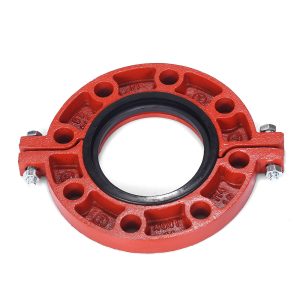
Before we wrap, a quick shout to Vicast, the folks who’ve been hammering out top-notch grooved fittings since 1982. Out of Hebei, China, they’ve got a sprawling 1 million square meter operation, cranking out ductile iron pieces that meet ASTM and AWWA specs to a T. With over 200 patents and a hand in six national standards, they’re not just suppliers—they’re shapers of the industry.
Their grooved flange adapters, like the XGQT13 series, handle 2-12 inch sizes at 225 or 363 PSI, perfect for pump interfaces. Epoxy-coated options fend off corrosion, and the whole lineup’s built for quick installs in fire protection system, fire protection, or industrial gigs. Vicast’s shipped to over 100 countries, backing big builds from stadiums to subways. If you’re tackling that connection challenge, their stuff’s battle-tested. Simple as that.
Wrapping It Up: Connect Smarter, Not Harder
Solving the connection challenge boils down to picking tools that fit the fight. Grooved flanges bridge pump flanges without the fuss, slashing time and risks while keeping systems humming. Whether it’s a quick retrofit or a mega-project, this approach pays off—in saved hours, fewer leaks, and peace of mind. Next time you’re staring down a mismatched setup, grab a grooved flange. You’ll wonder why you ever bothered with the old ways.
Frequently Asked Questions
What exactly is the connection challenge when using grooved flanges to interface with pump flanges?
It’s basically the hassle of marrying a rigid, bolted pump flange to a flexible grooved pipe run. Misalignments crop up, vibrations rattle things loose, and without a solid adapter, leaks sneak in. Grooved flanges fix that by providing a clean, pressure-rated transition—think 225 PSI hold without a sweat.
How do I pick the right grooved flange for my pump setup?
Start with your pump’s flange class—150# or 300#?—and match the size, say 4 inches. Check pressure needs; Vicast’s 363 PSI models shine for high-demand spots. Don’t forget the environment: Coated for outdoors, plain for dry indoors. A quick spec sheet review, and you’re set.
Can grooved flanges handle the vibration from industrial pumps?
Absolutely. Their design absorbs shakes better than bolted joints, cutting fatigue by up to 50%. In a pump house I worked, it meant zero failures over three years—vibes from 500 HP units just hummed along.
Are there any downsides to using grooved flanges for pump interfaces?
They’re speedy and tough, but yeah, upfront cost’s a tad higher than basic bolts. And if you’re in a super-corrosive spot, like seawater, double-check coatings. Still, for most jobs, the install savings bury that.
How long does it take to install a grooved flange on a pump?
From box to pressurized? 8-10 minutes if your crew’s sharp. Bolt it, groove it, couple it—done. Beats wrestling flanges for half an hour any day.

